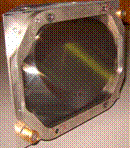Introducing quasi-optical terahertz circular dichroism spectroscopy
DOI:
https://doi.org/10.1109/ICATT.2017.7972579Keywords:
sub-Terahertz, circular dichroism, absorption, protein structural changeAbstract
A sub-Terahertz circular dichroism spectrometer is developed and built based on a vector network analyzer driven quasi-optical system at 220-325 GHz sub-THz frequency domain (VNA-CD). The main goal is to explore the potentially significant absorption features in THz signatures of aqueous protein samples.References
L. Whitmore and B. A. Wallace, “Protein secondary structure analyses from circular dichroism spectroscopy: methods and reference databases,” Biopolymers, vol. 89, no. 5, pp. 392-400, 2008. DOI: 10.1002/bip.20853.
R. W. Woody, “[4] Circular dichroism,” in Biochemical Spectroscopy, vol. 246. Academic Press, pp. 34–71, 1995.
J. Xu, G. J. Ramian, J. F. Galan, P. G. Savvidis, A. M. Scopatz, R. R. Birge, S. J. Allen, and K. W. Plaxco. “Terahertz circular dichroism spectroscopy: a potential approach to the in situ detection of life's metabolic and genetic machinery,” Astrobiology, vol. 3, no. 3, p. 489-504, 2003. DOI: 10.1089/153110703322610609.
J. Xu, J. Galan, G. Ramian, P. Savvidis, A. Scopatz, R. R. Birge, S. J. Allen, and K. Plaxco, “Terahertz circular dichroism spectroscopy of biomolecules,” Proc. SPIE, vol. 5268, pp. 19-26, 2004. DOI: 10.1117/12.518533.
F. W. Teale, “Cleavage of the haem-protein link by acid methylethylketone,” Biochimica et Biophysica Acta, vol. 35, pp. 543, Oct. 1959. PMID: 13837237.
B. Yang and R. S. Donnan, “Enhanced rapid and accurate sub-THz magneto-optical characterization of hexaferrite ceramics,” J. Magnetism and Magnetic Materials, vol. 323, no. 15, pp. 1992-1997, Aug. 2011. DOI: 10.1016/j.jmmm.2011.02.042.
Y. Wang, B. Yang, Y. Tian, R. S. Donnan, and M. J. Lancaster, “Micromachined thick mesh filters for millimeter-wave and terahertz applications,” IEEE Trans. Terahertz Sci. Technol., vol. 4, no. 2, pp. 247-253, 2014. DOI: 10.1109/TTHZ.2013.2296564.

